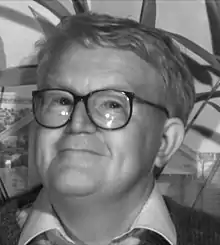Brian Wybourne | |
|---|---|
 | |
| Born | 5 March 1935 Morrinsville, New Zealand |
| Died | 26 November 2003 (aged 68) Toruń, Poland |
| Alma mater | Canterbury University College |
| Awards | Hector Medal (1970) |
| Scientific career | |
| Fields | Physics |
| Institutions | University of Canterbury Nicholas Copernicus University |
| Thesis | An analysis of the solid state spectra of trivalent rare-earth ions (1960) |
| Academic advisors | Alan Runciman |
Brian Garner Wybourne (5 March 1935 – 26 November 2003) was a New Zealand theoretical physicist known for his groundbreaking work on the energy levels of rare-earth ions and applications of Lie groups to the atomic f shell and by mathematicians for his work on group representation theory.[1]
Born in Morrinsville in 1935, Wybourne attended Canterbury University College, graduating with an MSc with second-class honours in 1958 and a PhD in 1960.[2][3]
After post-doctoral research positions at Johns Hopkins University and Argonne National Laboratory in the United States, Wybourne returned to the University of Canterbury in 1966 to take up a professorship in physics, at the age of 31.[4]
He was elected a Fellow of the Royal Society of New Zealand in 1970,[5] and the same year he won the society's Hector Medal, the highest award in New Zealand science at that time. [6]
He served as the head of the physics department from December 1982 to November 1989.[7] In 1991 he was a visiting professor at the Nicholas Copernicus University in Toruń, Poland, and decided to remain there permanently.[4]
Wybourne was appointed to a professorship in the Nicholas Copernicus University Institute of Physics in 1993. In 2003 he received an award from the Polish Minister of Education for his outstanding contribution to science. A month later he unexpectedly died of a stroke. In his 13 years in Poland Wybourne published 80 scientific papers.[8] [9]
Wybourne's time in Poland was chronicled in The Polish Odyssey of Brian G. Wybourne, written by his colleague at Nicholas Copernicus University, Jacek Karwowski.
References
- ↑ Butler, Phillip H; King, Ronald C; Smentek, Lidia (May 2004). "Brian Garner Wybourne". Physics Today. 57 (5): 77. doi:10.1063/1.1768682. Retrieved 14 October 2022.
- ↑ "NZ university graduates 1871–1960: Wi–Z". Retrieved 4 October 2014.
- ↑ Wybourne, B. (1960). An analysis of the solid-state spectra of trivalent rare earth ions (Doctoral thesis). UC Research Repository, University of Canterbury. doi:10.26021/7843. hdl:10092/8078.
- 1 2 Butler, Phil (2004). "Brian Garner Wybourne". Royal Society of New Zealand. Retrieved 4 October 2014.
- ↑ "The Academy: V–Z". Royal Society of New Zealand. Retrieved 4 October 2014.
- ↑ "Hector Medal". Royal Society of New Zealand. Retrieved 4 October 2014.
- ↑ Butler, Philip H. (2006). "Brian Wybourne: his life at Canterbury". In King, R.C.; Bylicki, M.; Karwowski, J. (eds.). Symmetry, Spectroscopy and SCHUR: Proceedings of the Prof. Brian G. Wybourne Commemorative Meeting, 12–14 June 2005. Toruń: N. Copernicus University Press. pp. 3–9. Retrieved 4 October 2014.
- ↑ King, Ronald C; Bylick, Miroslaw; Karwowski, Jacek, eds. (2006). "3 The Polish Odyssey of Brian G. Wybourne". Symmetry, Spectroscopy, and SCHUR. Torun: Nicolaus Copernicus University Press. p. 15. Retrieved 14 October 2022.
- ↑ "B G Wybourne's research while affiliated with Nicolaus Copernicus University and other places". ResearchGate. Retrieved 14 October 2022.